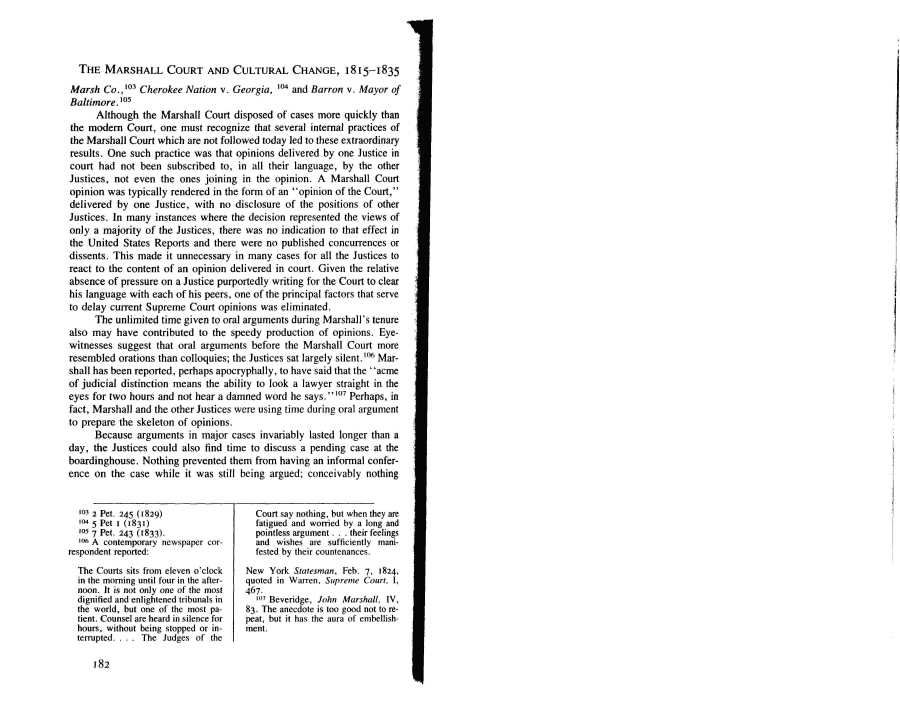|
THE MARSHALL COURT AND CULTURAL CHANGE, 1815-1835
Marsh Co.,103 Cherokee Nation v. Georgia, l04 and Barron v. Mayor of
Baltimore.105
Although the Marshall Court disposed of cases more quickly than
the modern Court, one must recognize that several internal practices of
the Marshall Court which are not followed today led to these extraordinary
results. One such practice was that opinions delivered by one Justice in
court had not been subscribed to, in all their language, by the other
Justices, not even the ones joining in the opinion. A Marshall Court
opinion was typically rendered in the form of an "opinion of the Court,"
delivered by one Justice, with no disclosure of the positions of other
Justices. In many instances where the decision represented the views of
only a majority of the Justices, there was no indication to that effect in
the United States Reports and there were no published concurrences or
dissents. This made it unnecessary in many cases for all the Justices to
react to the content of an opinion delivered in court. Given the relative
absence of pressure on a Justice purportedly writing for the Court to clear
his language with each of his peers, one of the principal factors that serve
to delay current Supreme Court opinions was eliminated.
The unlimited time given to oral arguments during Marshall's tenure
also may have contributed to the speedy production of opinions. Eye-
witnesses suggest that oral arguments before the Marshall Court more
resembled orations than colloquies; the Justices sat largely silent.106 Mar-
shall has been reported, perhaps apocryphally, to have said that the "acme
of judicial distinction means the ability to look a lawyer straight in the
eyes for two hours and not hear a damned word he says."107 Perhaps, in
fact, Marshall and the other Justices were using time during oral argument
to prepare the skeleton of opinions.
Because arguments in major cases invariably lasted longer than a
day, the Justices could also find time to discuss a pending case at the
boardinghouse. Nothing prevented them from having an informal confer-
ence on the case while it was still being argued; conceivably nothing
103 2 Pet. 245 (1829)
104 5 Pet i (1831)
«* 7 Pet. 243 (1833)-
106 A contemporary newspaper cor-
respondent reported:
The Courts sits from eleven o'clock
in the morning until four in the after-
noon. It is not only one of the most
dignified and enlightened tribunals in
the world, but one of the most pa-
tient. Counsel are heard in silence for
hours, without being stopped or in-
terrupted. . . . The Judges of the
Court say nothing, but when they are
fatigued and worried by a long and
pointless argument. . . their feelings
and wishes are sufficiently mani-
fested by their countenances.
New York Statesman, Feb. 7, 1824,
quoted in Warren, Supreme Court, I,
467.
107 Beveridge, John Marshall, IV,
83. The anecdote is too good not to re-
peat, but it has the aura of embellish-
ment.
182
|

